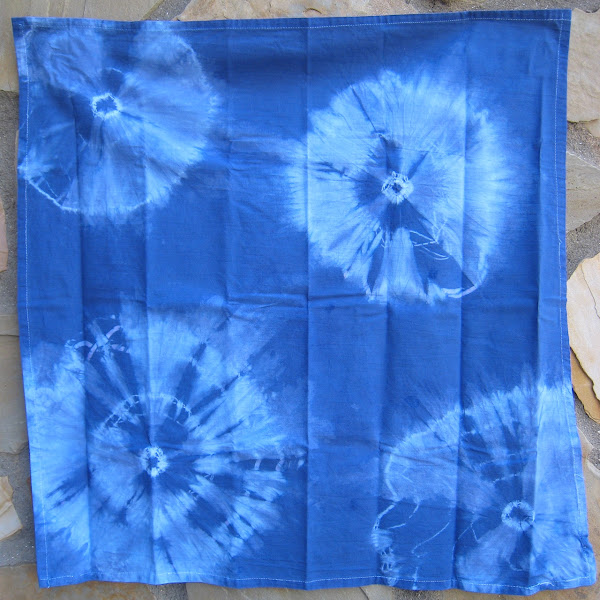It seems 2022 is the Year of Learning. At least, that's been the start. In addition to some knitting classes, I've taken two dye classes already this year. The first was shibori and the second was ice dyeing. Both techniques are easy and fun. Both used cotton fabric. Both used fiber-reactive dyes.
In January, Textile Appreciation Society of Atlanta held a shibori dye workshop at Southeast Fiber Arts Alliance. Our teacher was Sophie Monsibais. She was excellent — I definitely recommend her! She showed us three different techniques. The first is an accordion pleating technique which is the basis of many shibori patterns. The second was a twisting and binding technique that produces rings. The third — which I watched but didn't do — was binding rocks or pebbles.
Sophie had the dye vats already prepared. Although we were using
fiber-reactive dyes, Sophie heated them, because she said she gets better results if they "cook" for about 20 minutes. She showed us how to fold the fabric.
She provided rubber bands, string, and rocks so we could bind the fabrics. We
also had colored tags so we could tell our projects apart. We handed the items
to Sophie and her assistant, and they put them in the dye pots. They also had
a fixative pot for after-dyeing. When items were complete, they were rinsed
and put in a bucket of water where students could retrieve them. Basically,
students did the fun part and Sophie did the messy (but also fun) part. TASA
members are a mix of collectors and artists, meaning quite a few of the
members buy things but don't make things. It was especially exciting to see
these non-makers get fantastic results!
I didn't take pictures of my towels in progress, but here are the finished results.
For this towel, I accordion pleated in one direction and then the other, but I made the pleats smaller to larger both times. This is why the block pattern in the lower left corner is smaller than the block pattern in the upper right corner. That large block also took more dye because it was on the outside of the stack. A way to mitigate this would be to bind a piece of cardboard or wood to the outer layers, so they would only be exposed to the dye at the folded edges. Tight cross-binding with rubber bands or wide strings across the little square package produces fine lines through the pattern.In this second example, I twisted the fabric in four places. Each "pigtail" was then bound with rubber bands or thick string to create the concentric circles. The pleats of the twisted fabric create the radiating ribs of each "flower." Because the technique relies on natural processes, the patterning looks better when it seems random, rather than highly precise.
After this, I poked around YouTube a bit, watching videos of shibori dyeing. In my queue: watch the Natural Shibori: Itajime workshop over on Long Thread Media.
Tomorrow: ice dye!


Comments